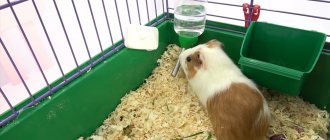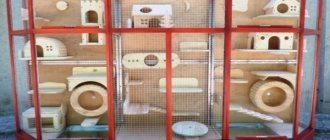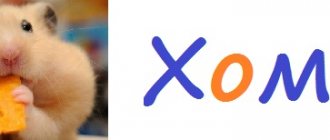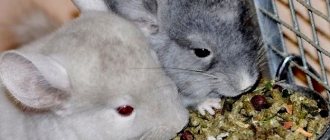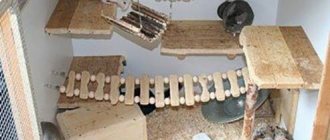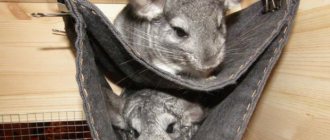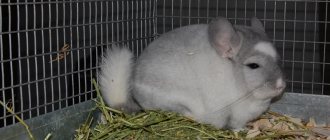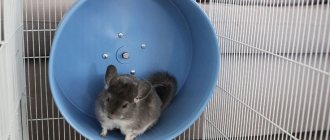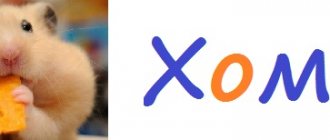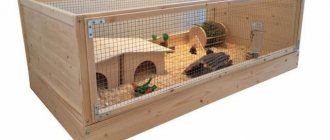Chinchillas, unlike many other animals, clean their fur of dirt not with water, but with the help of special sand. The fur of this rodent is characterized by increased density and thickness; it dries very slowly, so getting a chinchilla wet is only possible in the most extreme cases. Under natural conditions, the animal gets along well with sand, happily tumbling in it and cleaning its skin. At home, this pet also needs sand baths.
This item is necessary when keeping a chinchilla at home.
Why does a chinchilla need a swimsuit?
In their natural habitat, these rodents clean their thick fur in volcanic dust. It does not contain any microflora, therefore it is quite sterile. Fungi and mold do not develop in it. It does not irritate the animal’s skin at all, but cleans its undercoat well. Chinchillas are very active animals, this is also reflected in their bathing. To prevent constant spillage of the substance during this procedure, it is best to buy a special bathing suit.
An animal with such thick fur as a chinchilla is difficult to find among animals. But due to the fact that they do not have sebaceous glands, their fur quickly gets wet. Therefore, it is not advisable to wash them in water. After this, they may catch a cold, because... take a long time to dry. If, nevertheless, the owner decides to subject the rodent to a water procedure, then he should not dry it with a hairdryer after bathing. First you need to very carefully blot your pet with a soft cloth. Then you need to place it in your bosom and warm it with your body.
Static toys
Static toys are more like a piece of furniture for a chinchilla’s home. However, they help your pet lead an active lifestyle.
Shelves
For rodents, shelves are considered an ideal play option. Animals need regular exercise on their paws. So that the pet can easily jump onto the shelf, it is fixed at a height of 70-80 cm. If the animal falls from such a height, it will not be injured. You can make wood products yourself. They are good for grinding down claws and teeth.
Tunnels
Chinchilla tunnels are pipes of different diameters. In a cage with a large number of animals, they are an integral part. Animals can run after each other and hide. To prevent the pet from getting stuck, the tunnel is made with a diameter of 40 cm. Wood and plastic are used as materials. The wooden product has a metal edging. It protects the edges from the animal's teeth. There are many options for plastic tunnels. From a large quantity you can assemble a tunnel of a certain type. The best solution is a product made of translucent plastic. The chinchilla is comfortable and safe in it, and the owner can easily find the pet.
Sticks and ladders
Ordinary sticks cause great delight in the rodent. He can roll them and chew them. When placing an object between the shelf and the floor of the cage, the pet uses the stick as a ladder. You can buy a special ladder that performs the same functions as a stick. Often the animal rubs its back against it. For convenience, the product is attached to the cage wall in a vertical position.
Hammocks
If a small cage is used as a home for a rodent, a hammock is a good solution. It can be hung by the bars of the lid and used as a place for the animal to rest and sleep. A hammock helps save space for games. There are several types of hammocks: rope, wooden and plastic. They can also be single-tiered or multi-tiered. The animal can use the hammock as a place to play hide and seek.
Sewing a hammock at home
You can make a hammock for a chinchilla yourself. To do this, you need to prepare the following items:
- ruler or measuring tape;
- needle and thread;
- glue gun and scissors, chalk;
- felt sheet and edging material.
Step-by-step instructions for making a hammock with your own hands;
- Rectangles measuring 20x25 cm are cut out of a sheet of felt. Using needles, they are attached to each other and excess fabric is cut off. For marking use white chalk or soap. Draw an oval outline at a distance of 2 cm from the edges, then cut it out.
- The tape for edging is cut into four equal sections 10 cm long. Then they are folded in half, gluing the fold. Using a glue gun, attach the tape to the corners of one piece of felt. It is necessary to maintain a distance of 3 cm from the edge.
- Another piece is applied to this piece and sewn together with a needle and thread. To make the hammock voluminous and cozy, you can add cotton wool or padding polyester between the fabrics.
- Before attaching the finished product to the cage, you need to choose a suitable location. Ribbons are used as fastening.
At first, the animal may ignore the hammock. When the pet gets used to it, he will be happy to climb there. Perhaps the very next day the animal will use the new object as a place to rest.
How chinchillas “wash”
Typically, cleanliness is associated with water and cleaning products. Some pets are actually washed in water with a special shampoo. But in the case of a chinchilla, the situation is different. These animals “wash” in volcanic sand. Under no circumstances should it be replaced with regular river sand. This can cause irreparable harm to the animal, because regular sand contains a lot of bacteria. In the wild, it is volcanic dust that animals use to thoroughly clean their entire undercoat. In addition, it perfectly absorbs excess moisture from fur.
Real volcanic dust is sold in specialized pet stores. It must be hermetically packaged and not sold in bulk. Unfortunately, the quality of the product can only be checked after unpacking. If the dust has a shine, then it contains quartz particles that will spoil the fur. Good volcanic dust is matte and leaves a powdery feel on the palm. There are no scratching particles in it.
This substance is poured into a bathing suit for chinchillas in a layer of 5-6 cm. The bathing procedure is carried out once every 2-3 days. The time allowed for this is no more than an hour, depending on the activity of the individual. You cannot leave the bathing suit longer, otherwise the animal will go there to use the toilet. After each procedure, the sand is sifted and new sand is added. After 12-15 bathings, it is completely replaced with fresh one. You can add a little sulfur to it to prevent skin diseases. When changing sand, you need to wash and dry the bath thoroughly. Once a month it must be disinfected. Moisture must not get into the sand, because this can cause parasites to appear in it.
FAQ
In order for your pet to enjoy bathing in the sand without damaging its fur and skin, it is necessary to pay due attention to the choice of bathing suit, sand and all additional accessories for washing the animal. List of necessary items for swimming:
List of necessary items for swimming:
- comfortable and safe swimsuit;
- special sand, for example, volcanic sand for bathing rodents;
- medical sulfur for fur disinfection. This product can be purchased at pet stores, but medical sulfur should be used less frequently: once every few months unless otherwise specified by the veterinarian;
- talc for shine and smoothness of wool.
You can choose the appropriate sand for washing your animal only from the assortment available in pet stores. Ordinary river, sea, construction or any other sand will not be suitable for bathing your pet.
When choosing a bulk filler for a bath, you should pay special attention to the quality and composition of the sand. Soft, safe sand will not scratch the skin of your hands, so you can check the quality of this product at home by lightly rubbing the grains with your fingers
The filler should absorb moisture and fat well.
Have you tried making sand yourself?
Sometimes your pet will start eating sand for bathing, but there is nothing to worry about. The rodent does this to normalize the gastrointestinal tract, thus grinding food.
In some cases, this behavior may indicate that the pet does not have enough calcium. To replenish calcium, you can grind calcium tablets for rodents and give them a little at a time.
It is highly not recommended to wash your chinchilla in water! If the pet gets wet, it should be removed from the water as soon as possible and wrapped in a towel that absorbs moisture well. The fur should be blotted regularly with a dry cloth.
All windows must be closed and air conditioners must be turned off. Any, even the slightest drafts should be avoided.
Periodically, the towel in which the animal dries needs to be replaced with a dry one.
You can try to dry the fur with a hairdryer, holding the device with warm air at a distance of 20 cm from the animal’s fur. If the animal is afraid of noise, turn off the hair dryer and dry the fur with a towel.
You should not let your pet into the cage before it is completely dry. During drying, the animal should not freeze.
If the animal suddenly stops using the bathing suit, this may indicate some health problems, so the chinchilla should be shown to a veterinarian.
Sometimes sand or a bathing suit is not suitable for your pet. You can try to replace the filler, as well as the washing container itself.
Which material is better?
Pet stores provide different types of bathing containers that are made from a variety of materials. Each of them has its own advantages. But there are also some disadvantages.
Glass
A good choice is a glass bathing suit. It is usually made of durable glass in the form of a round aquarium. The chinchilla is not interested in this material, so the animal will not try to chew it. This bathhouse is easy to wash and keep clean. It is quite heavy, and the pet will not turn the container over during the hygiene procedure. But most importantly, the transparent walls allow you to easily observe the process of bathing your pet.
Plastic
A plastic bathing container must be made of high-quality material. Then it will last a long time. It is also easy to wash and clean. The disadvantages include the fact that it is not difficult for the animal to turn it over during the active procedure. Therefore, you should think about where to put the bathing suit to prevent this from happening. The pet can also chew the walls and swallow plastic pieces. Pet stores offer convenient plastic baths with a removable lid with a hole for entry. Their price is low.
Ceramic
The ceramic bathtub is quite stable. It washes well and does not absorb foreign odors. The main disadvantage is the opacity of the walls. You won't be able to watch your pet bathe. In this case, the animal is left to its own devices. The finished ceramic bathing suits are very decorative. They are made in the shape of a house or animal.
Wooden
A fairly popular material for swimsuits is wood. These chinchilla baths are relatively cheap and quite durable. They are made from various types of wood. It is impossible to make bathing containers from chipboard or fiberboard because of their harmful composition. Wooden bathing suits are short-lived and not particularly practical. They are difficult to clean after each procedure. Wood absorbs odors and moisture well. And the animal will definitely gnaw on such a structure.
From plywood
Plywood bathing suits are easy to complete in one day. You need to put together a box of a certain size with an open top. The front wall can be made of plexiglass or other transparent material. Then watching your pet will be a pleasure. But a plywood product has the same disadvantages as a wooden one.
Making a running wheel
You can make a toy for your pet yourself. Typically, homemade models are made of wood: the material is environmentally friendly, affordable and allows you to make a wheel of the required size. Even taking into account the fact that the animals will gnaw the wood, this version of the wheel is in many ways more economical than buying it. If desired, you can sheathe the outside of the wooden case with metal - this will extend the life of the running wheel.
For production you need:
- A sheet of plywood, no more than a centimeter thick,
- Electric jigsaw,
- Drill,
- Bearing or tensioner for an engine from any car,
- Self-tapping screws,
- Screws,
- Bolt,
- Small planks, three centimeters wide and about fifteen centimeters long.
In order to cut an even circle, first cut a small hole in the center of the plywood sheet with a jigsaw. The required radius is measured from its center. The jigsaw is bolted to the table through the hole made. During cutting, the plywood is rotated around its axis along the intended circle. The result is an even circle of the required diameter.
Next, you should cut out a ring with a similar outer diameter. The planks are fastened inside the wooden ring with thin self-tapping screws. You should first drill the holes with a drill and a 1.5 mm drill bit - this will protect against cracking. The ring is attached to the outside of the resulting plywood circle to give greater strength.
The next step is the rotation unit and fastening. For fastening, a bolt of at least fifteen centimeters long is used. A steel washer with a diameter larger than the bolt is placed on the bolt (so that it does not press into the plywood). The bolt is inserted inside the resulting structure and secured on the outside with a similar washer. A tensioner is put on the bolt and secured with self-tapping screws to a wooden plank. Advantage - the plastic tensioner cage does not produce noise when rotating. The toy is ready!
There are two ways to install a toy in a cage. The entire structure can be attached to a wooden plank or plank using one or two self-tapping screws and installed on the floor of the cage. The board should be wide enough - at least 10 cm. Otherwise, the animal will easily turn the toy over. In the second method, the bar to which the tensioner is screwed is secured with wire to the cage wall. This option is more convenient - the toy is attached more securely and even very active rodents cannot turn it over or move it.
Chinchillas are very active animals. Nature has designed it in such a way that they need to constantly move.
. In order to add variety to a pet's life, many owners try to equip the cage with all kinds of toys.
If a chinchilla lives in a small cage where there is no opportunity to move a lot, then it must have a running wheel. With its help, the animal will be able to maintain physical activity.
The sizes of running wheels should be selected taking into account the age and size of the chinchilla. Pet stores offer a simulator with various diameters - from 28 to 45 cm. The manufacturing material can be:
- metal;
- plastic;
- tree.
Wooden
The average cost of a custom wheel is 4,000 rubles
. They are mainly installed in display cages. A distinctive feature is their noiselessness. But they have certain disadvantages:
- chinchillas chew wooden parts, thereby disabling the exercise machine;
- the animal can make a toilet in the wheel, which will also ruin the structure.
Plastic
These simulators have a number of advantages:
- chinchillas have no desire to chew plastic;
- compact design;
- easy to clean and disinfect
; - has a low price - in the store you can find wheels from 200 rubles for small chinchillas and up to 3000 rubles for an adult.
Metal
Very durable structures, resistant to rodent teeth. They are easy to disassemble and disinfect. Pet stores offer two types of simulators:
- with a fine notch;
- with parallel bars.
Wheels, the base of which is made in the form of a fine notch, will protect the animal from the possibility of injury
. The paws do not fall into small holes; you can stop the movement at any time. If desired, the inner surface of the exercise machine can be protected by covering it with soft fabric.
The cost of such toys varies from 300 to 1500 rubles.
Treadmills for running
A track will be an excellent alternative to a wheel. There are two options: aluminum and plastic. They are safer for the chinchilla's health, as they do not overload the spine. Absolutely silent and do not threaten the animal with injury.
General requirements
For baths that are provided for bathing chinchillas, there are a number of requirements:
- The volume of the bathing suit is from five liters and above;
- the entrance to the container must correspond to the size of the animal;
- the more stable the chinchilla bathing vase, the safer it is for the animal to bathe in it;
- all sharp corners and notches at the entrance must be thoroughly sanded with sandpaper;
- The swimsuit should be securely fastened, especially if it is constantly in the cage.
Other interesting ideas
If you don’t want to spend money or don’t have extra finances, then this option will be your salvation for the short term. You can simply take the box and place it next to the tray, first shortening it a little. If your pet damages the cardboard a little, you can simply replace the feeder with an alternative box.
An equally interesting way would be to adapt a household basket for a feeder. The first thing you will need to do is cut two holes. Through one the rabbit will receive food, and through the other the owner will supply it. All dimensions must be calculated individually according to your room
It is important to make sure that the rabbit cannot crawl into the hole and does not injure itself.
A plastic bucket can be used in the same way. Before using this method, it is worth thoroughly rinsing the container so that no odors scare the animal away from the improvised feeder. The lid will serve as a limiter to prevent the rabbit from eating everything at once.
But it is worth noting that a rabbit can chew the bucket and get poisoned, so you should watch it with special attention
The most unusual option is the package holder. It is secured with a wire in the desired position and place. Such a device can be found in a store, its price does not exceed 300 rubles.
For information on how to make a hay barn for rabbits, see below.
How to make a bathing suit for a chinchilla with your own hands
You can make a bath for your pet yourself. It's not as difficult as it might seem at first glance.
Tools and materials
To do this, you need to set aside some free time and prepare everything you need:
- a plastic water bottle or a food-grade plastic canister with a volume of at least five liters;
- sharp knife;
- lighter;
- wire.
Manufacturing process
- In the side wall of the bottle or canister, you need to cut a circle of such a diameter that the pet can enter the container without much difficulty.
- Carefully melt the edges of the cutout with a lighter so that the animal does not get scratched.
- Secure the bath securely with wire so that it does not tip over when the rodent takes hygienic baths.
This design is not suitable for permanent placement in a cage, because the animal may chew the plastic. But for a half-hour swim it’s good. If the canister is transparent, this will allow everyone to watch the actions of the pet with interest.
Choosing a drinker
There are some requirements for a drinking device. It should be:
- closed;
- hold enough water;
- securely attached to the cage.
Drip drinker
If you choose a drip drinker, pay attention to its volume. It must be at least 150 ml, and the nipple is made of stainless material
This structure is secured to the outside of the cage with wire.
To prevent your pet from getting to it and damaging it, you can lay a sheet of galvanized steel between the tank and the cage.
Automatic
On sale you can find two types of automatic drinkers. The first is a bottle turned upside down, with the cap screwed on. A metal tube looks out of it, inside of which there is a steel ball that holds water.
The second is a nipple drinker. It is a valve, when pressed, water begins to flow. The liquid enters the container through a tube.
If you have one or two chinchillas on your farm, you can purchase any type of water bowl.
Automatic drinker of the second type
When a breeder has ten or more animals, it is better to connect a “chinchilla water supply” to the cages. This is a clear plastic tube that is used in car washes.
You can purchase it at an auto store, where you will also be offered tees, which will allow you to assemble an entire structure connected to a common water tank.
Plastic bottles are hung on the cages, and a “pipeline” is made at the bottom, which diverges into the compartments of the cage.
With such a system, it is important to ensure that the chinchillas do not chew through the tubes. If this happens, then a water leak is inevitable, and as a result, damaged floors and ceilings of neighbors
In addition, you will have to promptly repair the “water supply.”
Types of hay fields
Hay feeders are available in three variations:
A variety of hay for rabbits
They differ in their location relative to the cell. The first ones are attached inside it, and the second ones - on the outside. External hay boxes are used when the pet's cage is small. In order not to clutter the space, the nursery is installed outside, on a grid. In this case, the rabbits can easily take the hay when they want to eat, right through the bars.
V-shaped mangers can be used for double cages; they are installed in the wall between them, so that neighboring rabbits have the opportunity to feast on hay at the same time from the same feeder.
Reviews
Ekaterina, 36 years old: we decided to buy a plastic bathing suit for the chinchilla. They placed it on the bottom shelf in a display cage. There is also food and a scoop for pouring it into the feeder. A compartment was made in the structure itself so that the pet could jump down to the bathing suit. The animal quickly got used to the unusual object in the home. It is convenient to fill the bathing suit with volcanic sand. I liked that the container material is transparent. Thanks to this, you can watch the animal bathe in the sand.
Anastasia, 23 years old: we bathe chinchilla cubs in a special rectangular aquarium. It is high enough that rodents cannot get out of there. We buy volcanic sand at the nearest pet store. After reaching two months of age, we plan to accustom the animals to an adult bathing suit.
Bathing is one of the main procedures in the life of a chinchilla, without which the animal cannot remain healthy. Therefore, he needs to create comfortable conditions for the hygienic procedure. To do this, choose a spacious and safe product made of good material. But if you wish, it is possible to make a bathing suit for a chinchilla with your own hands. If you regularly take a bath, your pet will delight everyone with excellent health and a cheerful disposition.
Additional cage accessories
How to arrange a cage and what to place inside depends on the size. The larger the cell, the better. A large area will not only allow you to organize the space in an interesting way, but will also leave room for games and active movement. List of additional accessories:
When choosing an accessory for a cage, it is worth remembering that it must be safe. If the product is made of fabric, it is better to give preference to natural and undyed fabric. If it is made of wood, specify what type of wood was used. Some wood contains hazardous substances and can lead to poisoning.
Homemade accessories
They equip the cage not only with purchased goods. Some items can be made with your own hands. Most often, various shelves and ladders are made at home. Any pieces of plywood that can be attached to the walls of the cage using self-tapping screws or wire will be suitable as shelves. The number of shelves depends only on the height of the cage.
The ladder is both a delicacy and a game element. Usually it is made from twigs of different thicknesses, using the type of wood that rodents love: willow, birch, cherry, poplar, rowan. It is better to work with already dry twigs. If finding sufficiently dry wood is a problem in the summer, the pieces can be dried in the oven.
The branches must be divided: the long ones will go on the shelves, and the short ones (two centimeters each) will go on the crossbars. A hole two or three millimeters thick is drilled in the center of each crossbar. Similar holes are drilled in the shelves; about two centimeters must be removed from the edges. It is better to fasten the ladder links using wire. The end of the wire is inserted into the first shelf and a crossbar is strung on it. Secure it to the second shelf using a loop. Everything is repeated with each new shelf. The length of the finished ladder depends on the size of the cage.
Ideal home
The animal is very mobile, so they need a lot of space. When choosing a cage, first of all, be guided by its size. The minimum cage size for one animal is 50*50*70 (length*width*height). It is optimal to choose a more spacious home - 60*50*100.
The higher the cage, the better! Chinchillas love to jump and climb on bars. The cage must have at least 2 shelves.
You can also equip a storefront, since such a house has several advantages. It has closed walls, so dirt will not fly out. In addition, the showcase looks more stylish and can be successfully integrated into the interior.
Unfortunately, display cases are not sold in pet stores. You can order them from craftsmen or make them yourself. You can use wooden shelves or an old chest of drawers as a basis.
Accessories
Chinchillas definitely need:
- feeder;
- drinking bowl;
- house;
- stone for teeth point;
- manhole;
- stones and branches.
When your home is ready, start arranging it. First, she needs a water bowl and feeder. It is better to choose hanging options, so the animal will always have clean food and water. It is advisable to purchase metal utensils, as the wood will quickly wear down.
Be sure to put a house in the cage. It would be better if it were made of wood. Of course, sooner or later it will be eaten, but the animals will get great pleasure from such a shelter.
You can distract the animal from the point of its teeth on the cage or house using a special chalk stone. A teeth pointing stone can be purchased at any pet store and hung on the bars of the cage.
Large stones and branches of permitted trees can be placed in the cage (see section Feeding). The chinchilla will be pleased with the system of manholes and pipes where it can hide. If the size of the cage allows, hang a hammock in it. You can buy a hammock for ferrets or sew one yourself from thick fabric.
Toys
To prevent your fidget from getting bored, place several toys in the cage. Don't be discouraged if your upgrades don't make much of an impact. Chinchillas are completely unpredictable. They may be happy with an ordinary branch and not react at all to a new hole or house.
The best toys for chinchillas are wooden blocks and walnut shells. Watch how enthusiastically she drags them around the cage and gnaws them.
Standard running wheels for hamsters and guinea pigs have too large distances between the bars. While running fast, an animal can easily damage its paw. There are solid wheels made of wood, they are difficult to find, but they will suit the shushi well. If you are afraid that your pet is not getting enough activity, equip the cage with pipes and hang a few extra shelves.
